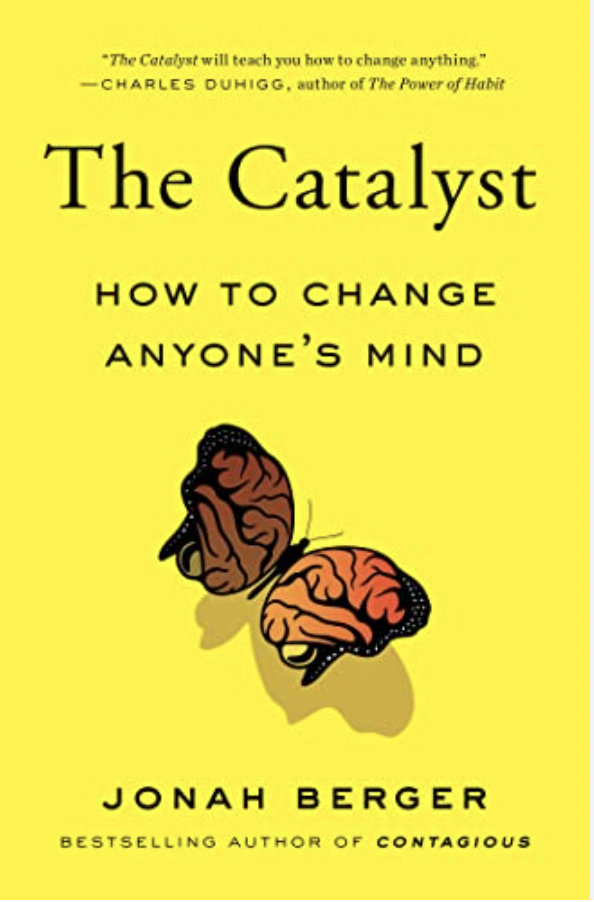I have a 2023 goal to read 25 books this year and I am screaming through that goal. I’ve read 9 so far and The Catalyst: How to Change Anyone’s Mind by Jonah Berger was the most helpful so far.
Sales or Product: Who Can Tell?
I picked the book up after reading this article from First Round Review, thinking it would be more Product Management-focused. I’m here to tell you this is Sales 101, packaged in an easy-to-understand framework with a lot of great stories. But there’s a lot of overlap between Product and Sales. One area I struggle with is evangelizing our roadmap and decisions to the rest of the organization. Our company heavily values sales input and doesn’t always seem to understand the value of feedback from existing customers, product analytics, support, etc. Sales doesn’t need to provide as much data as Product when it comes to making decisions. They’re fantastic sales people and they use their skills to influence executives too. (And we’re not the only ones. This is a great article that Cameron Bjorklund, our Lead Product Manager found: The Slippery Slope of Sales-Led Development.) I’ve realized in Product Development, we’ve got to learn how to sell too.
Removing Roadblocks & Lowering Barriers
Berger argues that being a catalyst is about “changing minds to remove roadblocks and lowering barriers that keep people from taking action”. There are five principles that keep people from changing their minds and The Catalyst explains all five. Then, explains how to get past them. They are Reactance, Endowment, Distance, Uncertainty, and Corroborating Evidence.
Reactance
Reactance is the idea that, when pushed, people push back. We need to get people to persuade themselves to change. Humans want control and autonomy. Anyone who tells us to do something, even if it’s a good idea, will naturally make us wonder if we should be doing the opposite. So, what can we do to allow people to “persuade themselves”? Allow them to choose. Provide a menu or choices. Ask questions instead of making statements or point out a gap between what they say and do.
Endowment
Endowment is the idea that we overvalue what we already have. If we feel some sense of ownership over something, it will be harder to give it up. That’s why giving out free samples or a few months free for a subscription product is so effective. Most people, if given the chance, will stick with the status quo. So, in order to get them to change, we must surface the cost of inaction. What’s the real opportunity cost for NOT changing?
Distance
If someone has an opinion that’s not close enough to our views, we tend to reject that idea outright. We like to pay attention to information that backs up our existing beliefs and conveniently ignore information that doesn’t. That’s what we’re seeing with politics these days. It’s really hard to make someone change political parties, but it is possible. There are people who live in the “movable middle” who don’t have strong views on particular topics. If their views are close enough to your views, they will listen to the arguments you’re making and you may be able to persuade them. You can also ask for less. When you’re selling something, instead of asking them to sign a huge contract right away, get them to come to a demo or sign-up for a 3-month trial. It is possible to reach people whose views are far away from yours. Political activists have found that something called “deep canvassing” works. Deep canvassing is having a 15-20 minute conversation with someone face-to-face. During that time, you find something that you can connect with. Maybe it’s a shared experience with a family member’s illness or a pet. Once you’ve found that connection, people are far more likely to listen.
Uncertainty
If you’re not sure, you just don’t act. Making something easy to try or reverse is key to overcoming uncertainty. Free trials, free shipping, easy returns, and discounts all help people get over their uncertainty.
Corroborating Evidence
Depending on how strongly you feel about something, you may need a mountain of evidence to convince you otherwise, or you may need only one recommendation. It turns out that hearing multiple recommendations for the same thing from people in different parts of your life helps convince you to try new things. This could be anything from a TV show to a new product. Frequency of those recommendations matters too. If you hear the same thing two days in a row, you’re more likely to try it. So, if you’re in marketing and you’re trying to change a loosely-held belief, you can use the “sprinkler” method to spray a little marketing to a large number of people. They may only hear the message once or twice, but that may be enough. If it’s a strongly-held belief you may need to use more of a “firehose” method to make sure you cover the same people multiple times.
Of course, we likely will need to pull more than one of the above levers to change someone’s mind! Overall, The Catalyst, was a fascinating book. Filled with some things you’ve probably heard before and some that were brand new to me! It’s worth picking up a copy.
